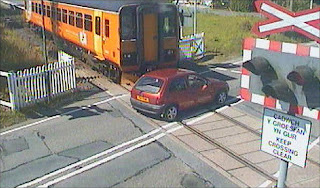In this first post we'll consider the modern roundabout and it's various components.
Modern Roundabout
Roundabouts differ from the a traffic circle, pictured below, in several distinct ways.
Traffic Circle
A roundabout always has some sort of signage which indicates to traffic entering the roundabout to yield to traffic already in the system.
Yielding Signage Placement
A traffic circle may not have this function, and will have a variety of rules or driving procedures governing how traffic navigates the system.
A roundabout will always slow traffic, while at the same time eliminating some of the disadvantages of a traditional intersection.
Sidewalks for pedestrians or bicyclists are typically offset from the circular traffic path for safety as can be see clearly from this photo.
Crosswalk Placement
To increase pedestrian safety, pedestrian islands or refuge islands are often incorporated.
Refuge Island
Roundabouts will typically have a center island which serves the function of a visual barrier for drivers entering the system so that they focus on traffic moving toward them and ignore traffic entering from the opposite side or traffic ahead of them thus reducing confusion.
Landscaped Center Island
Traffic flow in roundabouts is always directed only either in the clock-wise or counter-clockwise direction and is indicated with signage.
Traffic Flow Signage
Lighting for roundabouts follows a best practices methodology. It is advised that lighting be focused on the center island so that a driver encountering a roundabout is not surprised by it's presence in the roadway.
Roundabout Lighting
Roundabouts will also incorporate bicycle lanes.
Bicycle Lane Placement
Or pedestrian underpasses to increase safety.
Pedestrian Underpass under a Roundabout
NEXT WEEK: Railroad Crossings







.jpg)



.jpg)

















